生态环境学报 ›› 2023, Vol. 32 ›› Issue (9): 1632-1643.DOI: 10.16258/j.cnki.1674-5906.2023.09.010
收稿日期:2023-02-14
出版日期:2023-09-18
发布日期:2023-12-11
作者简介:王薇(1975年生)女,教授,博士,博士研究生导师,研究方向为建筑技术和人居环境。E-mail: vivi.gan@126.com
基金资助:Received:2023-02-14
Online:2023-09-18
Published:2023-12-11
摘要:
在城市化加速建设的情况下,街道峡谷已成为城市建成环境重要的空间组成部分。街道峡谷中PM2.5和PM10质量浓度存在显著差异,建筑空间形态是其重要的影响因素。选取安徽省合肥市包河区同安街道为研究对象,监测PM2.5和PM10质量浓度变化并对其进行空气质量评价,从多维度视角出发研究街道峡谷空间形态,并对街道峡谷中下沉广场这一特殊建筑空间形态提出优化策略。结果表明,1)街道峡谷内PM2.5、PM10的日均质量浓度均表现出多峰变化的特点,PM2.5和PM10质量浓度最大值出现在8:00-9:00区间,最小值出现在13:00-14:00区间,因此建议同安街道的居民尽量避开工作日早高峰时期,在下午13:00-16:00期间出行,以减少颗粒物对健康的危害。2)运用AQI对同安街道各监测点空气质量进行评价,结果表明其空气质量状况以优良为主,等级多分布在1级和2级。其中选点E所在的口袋公园空气质量最优,选点B所在的商业下沉广场空气质量最差。3)各个建筑空间形态设计指标对街道峡谷PM2.5和PM10质量浓度影响程度由大到小排序为:植被覆盖率>高宽比>建筑高度比>相对高程>建筑退界>天空开阔度。其中植被覆盖率与街道峡谷中的PM2.5和PM10质量浓度呈显著负相关,在街道退界空间中增加绿化可以显著改善其空气质量。4)适当提高建筑高宽比,采用底层架空以减少建筑物对近地面空气流动的阻碍作用,有利于改善街道峡谷内的空气质量。5)街道峡谷内下沉广场的高度越深,越不利于污染物在场地内的扩散,并对空气质量带来消极影响,而适当地增加下沉广场的宽度,对提高场地内的空气质量有一定作用。该文旨在为城市街道峡谷改善环境质量提供规划策略和科学依据,为城市街道峡谷空间形态优化设计和城市交通出行提供参考依据。
中图分类号:
王薇, 代萌萌. 基于颗粒物时空分布的街道峡谷空间形态研究——以合肥市同安街道为例[J]. 生态环境学报, 2023, 32(9): 1632-1643.
WANG Wei, DAI Mengmeng. Spatial Morphology of Street Canyons Based on the Spatial and Temporal Distribution of Particulate Matter: Taking Tongan Street in Hefei City as an Example[J]. Ecology and Environment, 2023, 32(9): 1632-1643.
| 设计指标 | 测点编号 | ||||
|---|---|---|---|---|---|
| A | B | C | D | E | |
| 建筑退界/m | 60 | 55 | 40 | 0 | 25 |
| 植被覆盖率/% | 0.21 | 0.16 | 0.17 | 0.12 | 0.25 |
| 高宽比 | 0.82 | 0.80 | 0.10 | 0.35 | 1.40 |
| 高度比 | 0.6 | 7.0 | 0.9 | 1.4 | 2.8 |
| 相对高程 | 15.85 | 0.0 | 16.47 | 11.58 | 9.54 |
| 天空开阔度 | 0.62 | 0.58 | 0.78 | 0.46 | 0.54 |
表1 街道峡谷测点信息
Table 1 Street canyon measurement point information
| 设计指标 | 测点编号 | ||||
|---|---|---|---|---|---|
| A | B | C | D | E | |
| 建筑退界/m | 60 | 55 | 40 | 0 | 25 |
| 植被覆盖率/% | 0.21 | 0.16 | 0.17 | 0.12 | 0.25 |
| 高宽比 | 0.82 | 0.80 | 0.10 | 0.35 | 1.40 |
| 高度比 | 0.6 | 7.0 | 0.9 | 1.4 | 2.8 |
| 相对高程 | 15.85 | 0.0 | 16.47 | 11.58 | 9.54 |
| 天空开阔度 | 0.62 | 0.58 | 0.78 | 0.46 | 0.54 |
| 仪器名称 | 监测参数 | 量程 | 测量精度 |
|---|---|---|---|
| ONETEST-500 粉尘浓度监测仪 | 温度/℃ | −20-60 | ±0.005 |
| 湿度/% | 0-100 | ±0.03 | |
| KESTREL 5500 手持式风速仪 | 风速/(m•s−1) | 0.6-60 | ±0.03 |
| 风向/(°) | 0-360 | ±5.00 | |
| ONETEST-500粉尘浓度监测仪 | PM2.5/(μg•m−3) | 0-1000 | ±0.10FS |
表2 测试仪器精度
Table 2 Test instrument accuracy
| 仪器名称 | 监测参数 | 量程 | 测量精度 |
|---|---|---|---|
| ONETEST-500 粉尘浓度监测仪 | 温度/℃ | −20-60 | ±0.005 |
| 湿度/% | 0-100 | ±0.03 | |
| KESTREL 5500 手持式风速仪 | 风速/(m•s−1) | 0.6-60 | ±0.03 |
| 风向/(°) | 0-360 | ±5.00 | |
| ONETEST-500粉尘浓度监测仪 | PM2.5/(μg•m−3) | 0-1000 | ±0.10FS |
| 类型 | 项目 | 说明 |
|---|---|---|
| 空气质量标准 计算公式 | 计算公式 | |
| 单位诠释 | I是空气质量指数,即AQI,为输出值;ρ是PM2.5日均值质量浓度,为输入值;Ilow是指数限值,与ρlow相对应,常量;Ihigh是对应于ρhigh的指数限值,常量;ρlow是小于或等于ρ的质量浓度限值,常量;ρhigh是大于或等于ρ的质量浓度限值,常量 | |
| 空气污染物浓度等级评价标准 | 计算意义 | 评价街道峡谷不同位置的空气质量水平 |
| 空气质量指数 | AQI≤50;50<AQI≤100;100<AQI≤150;150<AQI≤200;200<AQI≤300;AQI>300 | |
| 空气质量级别 | 1级;2级;3级;4级;5级;6级 | |
| 空气质量水平 | 优;良;轻度污染;中度污染;重度污染;严重污染 |
表3 空气污染物浓度等级计算公式及评价标准
Table 3 Calculation formula and evaluation standard of air pollutant concentration grade
| 类型 | 项目 | 说明 |
|---|---|---|
| 空气质量标准 计算公式 | 计算公式 | |
| 单位诠释 | I是空气质量指数,即AQI,为输出值;ρ是PM2.5日均值质量浓度,为输入值;Ilow是指数限值,与ρlow相对应,常量;Ihigh是对应于ρhigh的指数限值,常量;ρlow是小于或等于ρ的质量浓度限值,常量;ρhigh是大于或等于ρ的质量浓度限值,常量 | |
| 空气污染物浓度等级评价标准 | 计算意义 | 评价街道峡谷不同位置的空气质量水平 |
| 空气质量指数 | AQI≤50;50<AQI≤100;100<AQI≤150;150<AQI≤200;200<AQI≤300;AQI>300 | |
| 空气质量级别 | 1级;2级;3级;4级;5级;6级 | |
| 空气质量水平 | 优;良;轻度污染;中度污染;重度污染;严重污染 |
| 变量因子 | 风速 | |
|---|---|---|
| PM2.5 | 相关性 | −0.431** 1) |
| 显著性 | 0.002 | |
| PM10 | 相关性 | −0.498** |
| 显著性 | 0.000 | |
表4 街道峡谷内PM2.5和PM10与风速的相关性分析
Table 4 Correlation analysis of PM2.5, PM10 and wind speed in a street canyon
| 变量因子 | 风速 | |
|---|---|---|
| PM2.5 | 相关性 | −0.431** 1) |
| 显著性 | 0.002 | |
| PM10 | 相关性 | −0.498** |
| 显著性 | 0.000 | |
| 选点位置 | PM2.5 | PM10 | |||||||
|---|---|---|---|---|---|---|---|---|---|
| ρ(PM2.5)/(μg•m−3) | AQI | 空气质量级别 | 空气质量级别 | ρ(PM10)/(μg•m−3) | AQI | 空气质量水平 | 空气质量级别 | ||
| A | 37.24 | 52.8 | 良 | 2级 | 44.06 | 62.9 | 良 | 2级 | |
| B | 47.15 | 65.1 | 良 | 2级 | 55.40 | 79.1 | 良 | 2级 | |
| C | 40.59 | 56.9 | 良 | 2级 | 48.59 | 69.4 | 良 | 2级 | |
| D | 41.84 | 58.5 | 良 | 2级 | 49.77 | 71.1 | 良 | 2级 | |
| E | 30.61 | 43.7 | 优 | 1级 | 35.54 | 50.7 | 良 | 2级 | |
表5 空气污染物浓度等级评价标准
Table 5 Air Pollutant Concentration Level Evaluation Criteria
| 选点位置 | PM2.5 | PM10 | |||||||
|---|---|---|---|---|---|---|---|---|---|
| ρ(PM2.5)/(μg•m−3) | AQI | 空气质量级别 | 空气质量级别 | ρ(PM10)/(μg•m−3) | AQI | 空气质量水平 | 空气质量级别 | ||
| A | 37.24 | 52.8 | 良 | 2级 | 44.06 | 62.9 | 良 | 2级 | |
| B | 47.15 | 65.1 | 良 | 2级 | 55.40 | 79.1 | 良 | 2级 | |
| C | 40.59 | 56.9 | 良 | 2级 | 48.59 | 69.4 | 良 | 2级 | |
| D | 41.84 | 58.5 | 良 | 2级 | 49.77 | 71.1 | 良 | 2级 | |
| E | 30.61 | 43.7 | 优 | 1级 | 35.54 | 50.7 | 良 | 2级 | |
| 变量因子 | 空气温度 | 相对湿度 | |
|---|---|---|---|
| PM2.5 | 相关性 | −0.209 | 0.327* 1) |
| 显著性 | 0.145 | 0.020 | |
| PM10 | 相关性 | −0.223 | 0.317* |
| 显著性 | 0.120 | 0.025 | |
表6 街道峡谷内PM2.5和PM10与温湿度的相关性分析
Table 6 Correlation analysis of PM2.5 and PM10 and temperature and humidity in a street canyon
| 变量因子 | 空气温度 | 相对湿度 | |
|---|---|---|---|
| PM2.5 | 相关性 | −0.209 | 0.327* 1) |
| 显著性 | 0.145 | 0.020 | |
| PM10 | 相关性 | −0.223 | 0.317* |
| 显著性 | 0.120 | 0.025 | |
| 变量因子 | 植被覆盖率 | 建筑高度比 | 相对高程 | 天空开阔度 | 建筑退界 | 高宽比 | |
|---|---|---|---|---|---|---|---|
| PM2.5 | 相关性 | −0.892*1) | 0.494 | −0.461 | 0.070 | 0.183 | −0.590 |
| 显著性 | 0.042 | 0.398 | 0.434 | 0.911 | 0.768 | 0.295 | |
| PM10 | 相关性 | −0.904* | 0.441 | −0.407 | 0.100 | 0.169 | −0.639 |
| 显著性 | 0.035 | 0.458 | 0.497 | 0.873 | 0.786 | 0.246 | |
表7 街道峡谷形态指标与PM2.5、PM10质量浓度的相关性
Table 7 Correlation of street canyon morphological indicators with PM2.5 and PM10 mass concentrations
| 变量因子 | 植被覆盖率 | 建筑高度比 | 相对高程 | 天空开阔度 | 建筑退界 | 高宽比 | |
|---|---|---|---|---|---|---|---|
| PM2.5 | 相关性 | −0.892*1) | 0.494 | −0.461 | 0.070 | 0.183 | −0.590 |
| 显著性 | 0.042 | 0.398 | 0.434 | 0.911 | 0.768 | 0.295 | |
| PM10 | 相关性 | −0.904* | 0.441 | −0.407 | 0.100 | 0.169 | −0.639 |
| 显著性 | 0.035 | 0.458 | 0.497 | 0.873 | 0.786 | 0.246 | |
| 方案对比 | 模型要素特征 | 详细说明 | 备注 | |
|---|---|---|---|---|
| 原有方案 | 基准模型 | 下沉广场外部空间实测数据建立的数值模型 | 用做与其他方案对比 | |
| 优化 方案 | 方案1 体量设计 | 方案1-①;深度 | 统一增加下沉广场深度至7 m | 通过改变下沉广场的深度或宽度,改变其体量大小 |
| 方案1-②;宽度 | 统一增加下沉广场宽度至60 m | |||
| 方案1-③;深度+宽度 | 同时增加下沉广场的深度和宽度至7、60 m | |||
| 方案2 位置设计 | 方案2-①;前置 | 将下沉广场的位置放置到离建筑远,靠近道路的一侧,体量不变 | 通过移动下沉广场的位置优化下沉广场空间 | |
| 方案2-②;居中 | 将下沉广场放置于道路和建筑中间,体量不变 | |||
| 方案3 形状设计 | 方案3-①;方形 | 将原下沉广场由长条形改为正方形,并保持体量基本一致 | 通过改变下沉广场的形状优化下沉广场空间 | |
| 方案3-②;圆形 | 将原下沉广场由长条形改为圆形,并保持体量基本一致 | |||
| 方案4 绿化设计 | 方案4-①;树木+草地 | 将原下沉广场内增添绿化,包括树木和草坪等 | 通过改变下沉广场的环境优化下沉广场空间 | |
表8 建模方案
Table 8 Modelling solutions
| 方案对比 | 模型要素特征 | 详细说明 | 备注 | |
|---|---|---|---|---|
| 原有方案 | 基准模型 | 下沉广场外部空间实测数据建立的数值模型 | 用做与其他方案对比 | |
| 优化 方案 | 方案1 体量设计 | 方案1-①;深度 | 统一增加下沉广场深度至7 m | 通过改变下沉广场的深度或宽度,改变其体量大小 |
| 方案1-②;宽度 | 统一增加下沉广场宽度至60 m | |||
| 方案1-③;深度+宽度 | 同时增加下沉广场的深度和宽度至7、60 m | |||
| 方案2 位置设计 | 方案2-①;前置 | 将下沉广场的位置放置到离建筑远,靠近道路的一侧,体量不变 | 通过移动下沉广场的位置优化下沉广场空间 | |
| 方案2-②;居中 | 将下沉广场放置于道路和建筑中间,体量不变 | |||
| 方案3 形状设计 | 方案3-①;方形 | 将原下沉广场由长条形改为正方形,并保持体量基本一致 | 通过改变下沉广场的形状优化下沉广场空间 | |
| 方案3-②;圆形 | 将原下沉广场由长条形改为圆形,并保持体量基本一致 | |||
| 方案4 绿化设计 | 方案4-①;树木+草地 | 将原下沉广场内增添绿化,包括树木和草坪等 | 通过改变下沉广场的环境优化下沉广场空间 | |
| 变量因子 | 高度 | 原有方案 | 方案1-① | 方案1-② | 方案1-③ |
|---|---|---|---|---|---|
| PM2.5质量浓度/ (μg•m−3) | 0.5 m (k=0) |  |  | 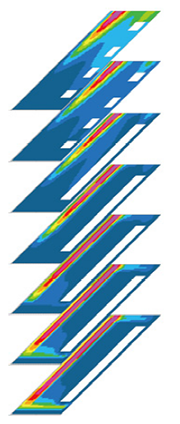 | 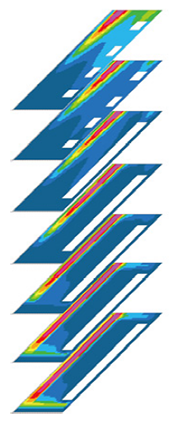 |
| 1.5 m (k=1) | |||||
| 3.5 m (k=3) | |||||
| 7.5 m (k=5) | |||||
| 17.5 m (k=7) | |||||
| 27.5 m (k=9) | |||||
| 42.5 m (k=12) | |||||
| 风速/ (m•s−1) | 0.5 m (k=0) | 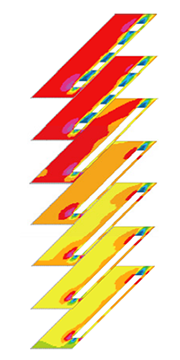 | 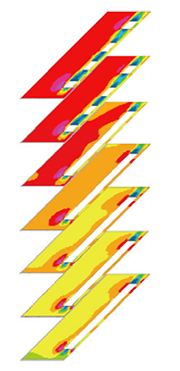 | 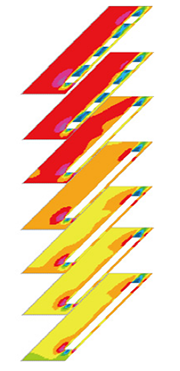 | 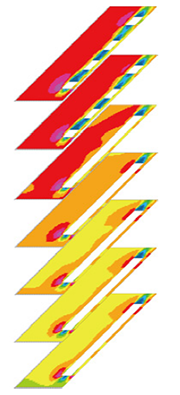 |
| 1.5 m (k=1) | |||||
| 3.5 m (k=3) | |||||
| 7.5 m (k=5) | |||||
| 17.5 m (k=7) | |||||
| 27.5 m (k=9) | |||||
| 42.5 m (k=12) |
表9 不同体量的下沉广场模拟可视化结果
Table 9 Visualisation of sunken plaza simulation with different volumes
| 变量因子 | 高度 | 原有方案 | 方案1-① | 方案1-② | 方案1-③ |
|---|---|---|---|---|---|
| PM2.5质量浓度/ (μg•m−3) | 0.5 m (k=0) |  |  |  |  |
| 1.5 m (k=1) | |||||
| 3.5 m (k=3) | |||||
| 7.5 m (k=5) | |||||
| 17.5 m (k=7) | |||||
| 27.5 m (k=9) | |||||
| 42.5 m (k=12) | |||||
| 风速/ (m•s−1) | 0.5 m (k=0) |  |  |  |  |
| 1.5 m (k=1) | |||||
| 3.5 m (k=3) | |||||
| 7.5 m (k=5) | |||||
| 17.5 m (k=7) | |||||
| 27.5 m (k=9) | |||||
| 42.5 m (k=12) |
| 变量因子 | 高度 | 原有方案 | 方案2-① | 方案2-② |
|---|---|---|---|---|
| PM2.5质量浓度/ (μg•m−3) | 0.5 m (k=0) |  |  |  |
| 1.5 m (k=1) | ||||
| 3.5 m (k=3) | ||||
| 7.5 m (k=5) | ||||
| 17.5 m (k=7) | ||||
| 27.5 m (k=9) | ||||
| 42.5 m (k=12) | ||||
| 风速/ (m•s−1) | 0.5 m (k=0) | 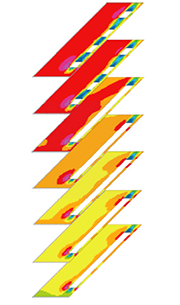 | 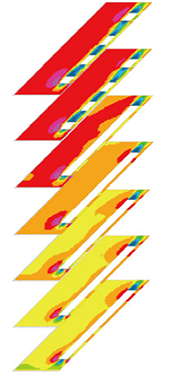 |  |
| 1.5 m (k=1) | ||||
| 3.5 m (k=3) | ||||
| 7.5 m (k=5) | ||||
| 17.5 m (k=7) | ||||
| 27.5 m (k=9) | ||||
| 42.5 m (k=12) |
表10 不同位置的下沉广场模拟可视化结果
Table 10 Visualisation of sunken plaza simulations with different locations
| 变量因子 | 高度 | 原有方案 | 方案2-① | 方案2-② |
|---|---|---|---|---|
| PM2.5质量浓度/ (μg•m−3) | 0.5 m (k=0) |  |  |  |
| 1.5 m (k=1) | ||||
| 3.5 m (k=3) | ||||
| 7.5 m (k=5) | ||||
| 17.5 m (k=7) | ||||
| 27.5 m (k=9) | ||||
| 42.5 m (k=12) | ||||
| 风速/ (m•s−1) | 0.5 m (k=0) |  |  |  |
| 1.5 m (k=1) | ||||
| 3.5 m (k=3) | ||||
| 7.5 m (k=5) | ||||
| 17.5 m (k=7) | ||||
| 27.5 m (k=9) | ||||
| 42.5 m (k=12) |
| 变量因子 | 高度 | 原有方案 | 方案3-① | 方案3-② |
|---|---|---|---|---|
| PM2.5质量浓度/ (μg•m−3) | 0.5 m (k=0) |  |  |  |
| 1.5 m (k=1) | ||||
| 3.5 m (k=3) | ||||
| 7.5 m (k=5) | ||||
| 17.5 m (k=7) | ||||
| 27.5 m (k=9) | ||||
| 42.5 m (k=12) | ||||
| 风速/(m•s−1) | 0.5 m (k=0) | 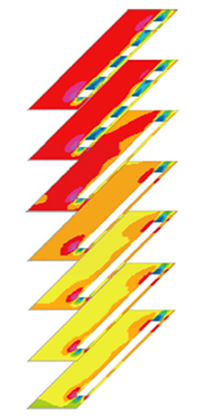 | 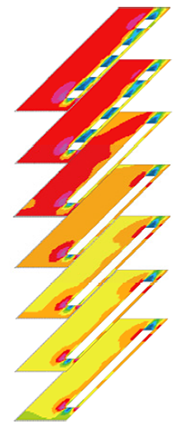 | 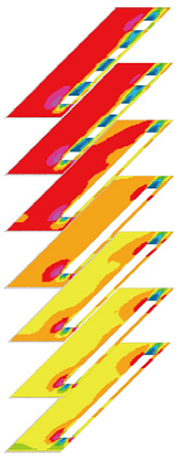 |
| 1.5 m (k=1) | ||||
| 3.5 m (k=3) | ||||
| 7.5 m (k=5) | ||||
| 17.5 m (k=7) | ||||
| 27.5 m (k=9) | ||||
| 42.5 m (k=12) |
表11 不同形状的下沉广场模拟可视化结果
Table 11 Simulation visualisation of sunken squares with different shapes
| 变量因子 | 高度 | 原有方案 | 方案3-① | 方案3-② |
|---|---|---|---|---|
| PM2.5质量浓度/ (μg•m−3) | 0.5 m (k=0) |  |  |  |
| 1.5 m (k=1) | ||||
| 3.5 m (k=3) | ||||
| 7.5 m (k=5) | ||||
| 17.5 m (k=7) | ||||
| 27.5 m (k=9) | ||||
| 42.5 m (k=12) | ||||
| 风速/(m•s−1) | 0.5 m (k=0) |  |  |  |
| 1.5 m (k=1) | ||||
| 3.5 m (k=3) | ||||
| 7.5 m (k=5) | ||||
| 17.5 m (k=7) | ||||
| 27.5 m (k=9) | ||||
| 42.5 m (k=12) |
| 变量因子 | 高度 | 绿化方案 | 基准模型 |
|---|---|---|---|
| PM2.5质量浓度/ (μg•m−3) | 0.5 m (k=0) |  |  |
| 1.5 m (k=1) | |||
| 3.5 m (k=3) | |||
| 7.5 m (k=5) | |||
| 17.5 m (k=7) | |||
| 27.5 m (k=9) | |||
| 42.5 m (k=12) | |||
| 风速/ (m•s−1) | 0.5 m (k=0) | 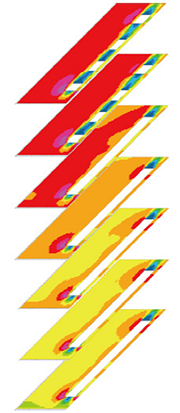 | 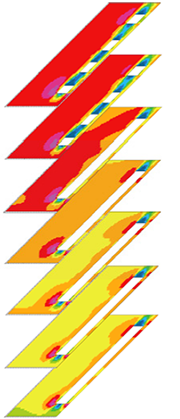 |
| 1.5 m (k=1) | |||
| 3.5 m (k=3) | |||
| 7.5 m (k=5) | |||
| 17.5 m (k=7) | |||
| 27.5 m (k=9) | |||
| 42.5 m (k=12) |
表12 不同绿化的下沉广场模拟可视化结果
Table 12 Simulation visualisation of sunken squares with different greenery
| 变量因子 | 高度 | 绿化方案 | 基准模型 |
|---|---|---|---|
| PM2.5质量浓度/ (μg•m−3) | 0.5 m (k=0) |  |  |
| 1.5 m (k=1) | |||
| 3.5 m (k=3) | |||
| 7.5 m (k=5) | |||
| 17.5 m (k=7) | |||
| 27.5 m (k=9) | |||
| 42.5 m (k=12) | |||
| 风速/ (m•s−1) | 0.5 m (k=0) |  |  |
| 1.5 m (k=1) | |||
| 3.5 m (k=3) | |||
| 7.5 m (k=5) | |||
| 17.5 m (k=7) | |||
| 27.5 m (k=9) | |||
| 42.5 m (k=12) |
| [1] |
ANNESI-MAESANO I, FORASTIERE F, BALMES J, et al., 2021. The clear and persistent impact of air pollution on chronic respiratory diseases: A call for interventions[J]. European Respiratory Journal, 57(3): 2002981.
DOI URL |
| [2] |
DUAN C E, LU W Z, ZHANG Y W, et al., 2018. A new urban canopy parameterization scheme for wind environment simulations[J]. Indoor and Built Environment, 27(3): 402-422.
DOI URL |
| [3] | GLENCROSS D A, HO T R, CAMIÑA N, et al., 2020. Air pollution and its effects on the immune system[J]. Free Radical Biology and Medicine: The Official Journal of the Oxygen Society, 151: 56-58. |
| [4] |
HAMANAKA R B, MUTLU G M, 2018. Particulate matter air pollution: effects on the cardiovascular system[J]. Frontiers in Endocrinology, 9(16): 680.
DOI URL |
| [5] |
KIM H, KIM W H, KIM Y Y, et al., 2020. Air pollution and central nervous system disease: A review of the impact of fine particulate matter on neurological disorders[J]. Frontiers in Public Health, 8:575330.
DOI URL |
| [6] | LEE J S, KIM J T, LEE M G, 2013. Mitigation of urban heat island effect and greenroofs[J]. Indoor & Built Environment, 23(1): 62-69. |
| [7] | SZYSZKOWICZ M, SCHOEN S, ANGELIS N D, 2021. Air pollution and emergency department visits for disease of the genitourinary system[J]. Environmental Health Insights, 15: 11786302211025360. |
| [8] | United Nations, 2019. World Urbanization Prospects: The 2018 Revision[EB/OL]. (2019-08-30) [2019-08-30].https://population.un.org/wup/. |
| [9] |
VARDOULAKIS S, FISHER B E A, PERICLEOUS K, et al., 2003. Modelling air quality in street canyons: A review[J]. Atmospheric Environ, 37(2): 155-182.
DOI URL |
| [10] |
WANG L, TIAN W X, ZHAO X Y, et al., 2022. Numerical simulation of the effects of canopy properties on airflow and pollutant dispersion in street canyons[J]. Indoor and Built Environment, 31(2): 466-478.
DOI URL |
| [11] | WANG Q, WANG Y, ZHAO J Y, et al., 2015. Diffusion factors of street canyon pollutants in the cold winter of Xi’an city based on back propagation neural network analysis[J]. Indoor & Built Environment, 24(8): 91-114. |
| [12] |
WANG W, XIA S H, ZHU Z Y, et al., 2022. Spatiotemporal distribution of negative air ion and PM2.5 in urban residential areas[J]. Indoor and Built Environment, 31(4): 1127-1141.
DOI URL |
| [13] | XUE F, LI X F, 2017. The impact of roadside trees on traffic released PM10 in urban street canyon: Aerodynamic and deposition effects[J]. Sustain Cities & Society, 30: 195-204. |
| [14] |
ZHANG A Q, XIA C, LI W F, 2022. Exploring the effects of 3D urban form on urban air quality: Evidence from fifteen megacities in China[J]. Sustainable Cities and Society, 78: 103649.
DOI URL |
| [15] |
ZHANG Y W, GU Z L, LEE S C, et al., 2011. Numerical simulation and in situ investigation of fine particle dispersion in an actual deep street canyon in Hong Kong[J]. Indoor and Built Environment, 20(2): 206-216.
DOI URL |
| [16] |
ZHANG Y W, GU Z L, WANG Z S, et al., 2013. Advances in the fine scale simulation of urban wind environment[J]. Indoor and Built Environment, 22(1): 332-336.
DOI URL |
| [17] | ZHANG Y W, GU Z L, YU C, 2012. Time-series numerical simulation of wind flow within urban canopy layer and its integration effect for prediction of pollutant concentration variation[J]. Indoor & Built Environment, 21(3): 355-357. |
| [18] |
ZHANG X, ZHANG K, LIU H P, et al., 2020. Pollution sources of atmospheric fine particles and secondary aerosol characteristics in Beijing[J]. Journal of Environmental Sciences, 95(1): 91-98.
DOI URL |
| [19] |
ZHAO J J, DONG J K, ZHANG X H, et al., 2023. Field measurement of microclimate of sunken square and its effect on indoor environment of underground metro station in subtropical region[J]. Building and Environment, 228: 109873.
DOI URL |
| [20] | 戴菲, 陈明, 王敏, 等, 2020. 城市街区形态对PM10、PM2.5的影响研究——以武汉为例[J]. 中国园林, 36(3): 109-114. |
| DAI F, CHEN M, WANG M, et al., 2020. Effect of urban block form on reducing particulate matter: A case study of Wuhan[J]. Chinese Landscape Architecture 36( 3): 109-114. | |
| [21] | 狄育慧, 陶钰, 蒋婧, 等, 2021. 西安地区下沉式广场风环境的测试与分析[J]. 西安工程大学学报, 35(4): 50-54, 70. |
| DI Y H, TAO Y, JIANG J, et al., 2021. Test and analysis of wind environment of sunken square in Xi’an[J]. Journal of Xi’an Polytechnic University, 35(4): 50-54, 70. | |
| [22] | 丁一汇, 李巧萍, 柳艳菊, 等, 2009. 空气污染与气候变化[J]. 气象, 35(3): 3-14, 129. |
| DING Y H, LI Q P, LIU Y J, 2009. Atmospheric aerosols air pollution and climate change[J]. Meteorological Monthly, 35(3): 3-14, 129. | |
| [23] |
李月雯, 杨满场, 彭翀, 等, 2020. 面向健康微气候环境的城市设计导则优化策略[J]. 南方建筑 (4): 28-33.
DOI |
|
LI Y W, YANG M C, PENG C, et al., 2020. Optimisation strategy of urban design guidelines for a healthy microclimate environment[J]. South Architecture (4): 28-33.
DOI |
|
| [24] | 李绥, 石铁矛, 周诗文, 等, 2016. 城市三维格局影响下的污染气体扩散效应分析[J]. 沈阳建筑大学学报(自然科学版), 32(6):1111-1121. |
| LI S, SHI T M, ZHOU S W, et al., 2016. Diffusion effects of atmospheric pollutants on the three dimensional landscape pattern of urban block[J]. Journal of Shenyang Jianzhu University (Natural Science), 32(6): 1111-1121. | |
| [25] | 郭昊栩, 邓孟仁, 李颜, 2014. 下沉广场对地下商业空间通风性能的影响[J]. 华南理工大学学报(自然科学版), 42(6):114-120. |
| GUO H X, DENG M R, LI Y, 2014. Effect of sunken plaza on ventilation performance of underground commercial space[J]. Journal of South China University of Technology (Natural Science Edition), 42(6):114-120. | |
| [26] | 洪小春, 季翔, 肖鸿飞, 等, 2021. 不同空间尺度下城市下沉广场与周边环境的整合机制——以上海创智天地下沉广场为例[J]. 现代城市研究 (6): 52-59. |
| HONG X C, JI X, XIAO H F, et al., 2021. Integration mechanism of urban sunken square and surrounding environment under different spatial scales: A case study of Shanghai Chuangzhitiandi sunken square[J]. Modern Urban Research (6): 52-59. | |
| [27] | 回景淏, 王岩, 孙立新, 2022. 天津城市下沉广场冬季热环境研究[J]. 建筑科学, 38(12): 101-107, 224. |
| HUI J H, WANG Y, SUN L X, 2022. Study on thermal environment of Tianjin sunken plaza in winter[J]. Building Science, 38(12): 101-107, 224. | |
| [28] | 中华人民共和国生态环境部, 2018. 关于发布《环境空气质量标准》(GB 3095—2012)修改单的公告[N/OL]. (2021-06-04) [2021-06-04]. http://www.mee.gov.cn/gkml/sthjbgw/sthjbgg/201808/t20180815_451398.htm. |
| Ministry of Ecology and Environment of the People's Republic of China, 2018. Announcement on Issuing the Revision Sheet of Ambient Air Quality Standard (GB 3095—2012)[N/OL]. (2021-06-04) [2021-06-04]. http://www.mee.gov.cn/gkml/sthjbgw/sthjbgg/201808/t20180815_451398.htm. | |
| [29] | 中华人民共和国生态环境部, 2022. 中国移动源环境管理年报(2022)[N/OL]. (2022-12-07) [2022-12-07]. https://www.mee.gov.cn/ywdt/xwfb/202212/t20221207_1007157.shtml. |
| Ministry of Ecology and Environment of the People's Republic of China, 2022. Annual report on environmental management of mobile sources in China (2022)[N/OL]. (2022-12-07) [2022-12-07]. https://www.mee.gov.cn/ywdt/xwfb/202212/t20221207_1007157.shtml. | |
| [30] | 国家统计局, 2023. 王萍萍: 人口总量略有下降城镇化水平继续提高[N/OL]. (2023-01-18) [2023-01-18]. http://www.stats.gov.cn/sj/sjjd/202302/t20230202_1896742.html. |
| National Bureau of Statistics, 2023. Wang Pingping: Total population declines slightly, urbanization level continues to rise[N/OL]. (2023-01-18) [2023-01-18]. http://www.stats.gov.cn/sj/sjjd/202302/t20230202_1896742.html. | |
| [31] | 任蘇琪, 黄远东, 崔鹏义, 2021. 架空建筑街谷内流动与污染物扩散的数值模拟研究[J]. 上海理工大学学报, 43(4): 368-377. |
| REN S Q, HUANG Y D, CUI P Y, 2021. Numerical simulation studies on airflow and pollutant dispersion in street canyons with void decks[J]. University of Shanghai for Science and Technology, 43(4): 368-377. | |
| [32] |
王薇, 程歆玥, 胡春, 等, 2021. 城市街道峡谷PM2.5时空分布特征与空气质量评价——以合肥市长淮街道为例[J]. 生态环境学报, 30(11): 2157-2164.
DOI |
| WANG W, CHENG X Y, HU C, et al., 2021a. Spatio-temporal distribution characteristics of PM2.5 and air quality evaluation in urban street canyons: Take Changhuai street in Hefei as an example[J]. Ecology and Environmental Sciences, 30(11): 2157-2164. | |
| [33] | 吴凌云, 谢军飞, 张欣, 2021. 冬季采暖优化对北京地区空气质量的影响[J]. 气候与环境研究, 26(4): 391-402. |
| WU L Y, XIE J F, ZHANG X, 2021. Impacts of clean-energy heating transformation in winter on the air quality in Beijing[J]. Climatic and Environmental Research, 26(4): 391-402. | |
| [34] |
杨满场, 彭翀, 明廷臻, 2019. 应对机动车尾气污染的临街建筑控制策略研究——以武汉市中山大道街区为例[J]. 南方建筑 (2): 75-80.
DOI |
|
YANG M C, PENG C, MING Y Z, 2019. Study of the control strategy of building facades to vehicle exhaust pollution: A case study on Wuhan Zhongshan road block[J]. South Architecture (2): 75-80.
DOI |
|
| [35] | 赵晨曦, 王云琦, 王玉杰, 等, 2014. 北京地区冬春PM2.5和PM10污染水平时空分布及其与气象条件的关系[J]. 环境科学, 35(2): 418-427. |
| ZHAO C X, WANG Y Q, WANG Y J, et al., 2014. Temporal and spatial distribution of PM2.5 and PM10 pollution status and the correlation of particulate matters and meteorological factors during winter and spring in Beijing[J]. Environmental Science, 35(2): 418-427. | |
| [36] | 周姝雯, 唐荣莉, 张育新, 等, 2018. 街道峡谷绿化带设置对空气流场及污染分布的影响模拟研究[J]. 生态学报, 38(17): 6348-6357. |
| ZHOU S Q, TANG R L, ZHANG Y X, et al., 2018. Simulation study on the influence of green belt settings on air-flow and pollution distribution in street canyon[J]. Acta Ecologica Sinica, 38(17): 6348-6357. |
| [1] | 王薇, 程歆玥. 合肥市不同功能街道峡谷PM2.5和PM10时空分布特征及影响因素分析[J]. 生态环境学报, 2022, 31(3): 524-534. |
| [2] | 王薇, 程歆玥, 胡春, 夏斯涵, 王甜. 城市街道峡谷PM2.5时空分布特征与空气质量评价——以合肥市长淮街道为例[J]. 生态环境学报, 2021, 30(11): 2157-2164. |
| 阅读次数 | ||||||
|
全文 |
|
|||||
|
摘要 |
|
|||||

